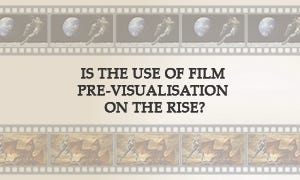Is the use of film pre-visualisation on the rise?
A single shot within a modern Hollywood blockbuster can be incredibly complex, take years to create and require the coordination of hundreds of people around the world.
To ensure that shots are created on time, on budget and as the director intended, they need to plan out every detail before anything is actually shot. Hand-drawn storyboards have long been used by filmmakers but can be insufficient for the most complex of visual effects shots.
Enter pre-visualisation (or "pre-vis"). These are 3d animations mocking up what the final shot will look like, including characters, animation, effects, camera moves and more. They look far more basic than the final shot but contain all the vital information to get everyone working to the same goal.
As 3D animation packages become cheaper and easier to use, and as the final films are becoming more visually complex, it stands to reason that pre-vis will be used more often. But how much so?
I looked at the credits behind 8,095 movies which reached US cinemas over the past two decades to find out.
How many films use pre-vis?
In 2000, just 3.6% of films had a pre-vis credit. This tripled over the next decade to 10.3% by 2010, but the following decade saw a flattening in the growth, and by 2019 the figure stood at 13.6%.
However, the chart above does not tell the full story. While the number of films which used any amount of pre-vis did not grow significantly in the past decade, the number of people employed in pre-vis jobs did. That's because films moved from just using pre-vis for a couple of shots to planning out long sequences or, in some cases, the entire movie.
The number of pre-vis credits on movies grew more than four times between 2010 and 2019. The chart below shows this growth via the average number of pre-vis credits on movies which used the process.
What types of films use pre-visualisation most?
The growth in pre-vis has been largely led by the biggest-budgeted Hollywood movies. This is for a couple of seemingly-contrary reasons:
Pre-vis costs money. It's a process which takes time and money to set up, meaning that most smaller films don't have funds to cover it.
Pre-vis saves money. One of the best ways to save money for a film is to ensure good communication and coordination between the people involved. Bad planning can cost Hollywood movies many millions of dollars, meaning there is a strong financial incentive to use any method which aligns everyone's understanding.
The majority of movies costing over $100m have been using pre-vis since the mid-2000s. The more interesting trend for me is the rise of pre-vis among movies costing between $50m and $100m. This is a consequence of the technology being pioneered by the largest movies and eventually trickling down to smaller productions as it becomes easier, cheaper to use and more widely supported.
Pre-vis can be used on any film but is most useful for films which heavily utilise visual effects. Therefore it is no surprise that it's most frequently used on fantasy, adventure and sci-fi movies.
Notes
Today’s research looks at all live-action movies released theatrically in North America between 1st January 2000 and 31st December 2019. I opted to leave out 2020 as the lack of theatrical openings mean it's hard to know which films should be included. The raw data came from IMDb, The-Numbers and Wikipedia.
Three-quarters of pre-vis credits were roles such as "pre-vis artists" or "pre-vis animator", 23.8% were more senior roles, such as "pre-vis supervisor" or "visualization executive producer", and 3.2% were more indirect jobs such as "consultant" or "accountant".
I opted to use the phrases "pre-visualisation" and "pre-vis" but alternative phrases include "pre vis", "pre viz", "pre-viz", "previs", "previz". I've also seen it occasionally referred to as "animatics" although technically that's a slightly different process, whereby 2D storyboard drawings are animated. I therefore did not include animatic-based credits in today's research.
I also include "post-vis" within pre-vis. This is the process of including final live-action elements from the shoot into the pre-vis mock-up, to get ever-closer to the final shot. This is most useful when some elements have already been shot but there are still complicated shots or visual effects elements to create. I did hope to split post-vis out into its own sidebar research but it seems to me that the line between pre- and post-vis work is so blurred that it's not possible.
I've tried to keep the descriptions of pre-vis and its processes light as I'm not an expert on the topic. If I have described anything incorrectly, please do drop me a line and I'll fix it.
There's a chance that today's figures are an under-count of the true situation. Visual effects crews don't always receive a named credit on all the films they worked on and so the onus falls on each person to add their missing credits to sites like IMDb. The more senior someone is, the less they may worry about a missing credit as their past work and contacts in the industry will be all they need to secure future work. That said, I do not think any missing credits will be effecting the overall trends we have seen above (i.e. growth, relation to budget or genre connections).
Epilogue
If you want to learn more about pre-visualisation, I recommend reading this piece by Insider and checking out the video below.







